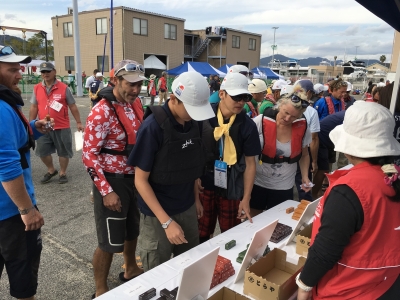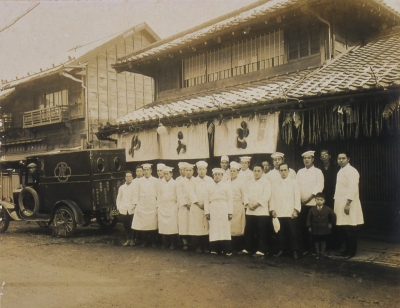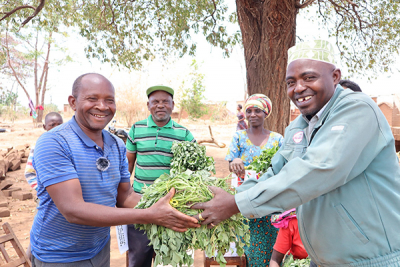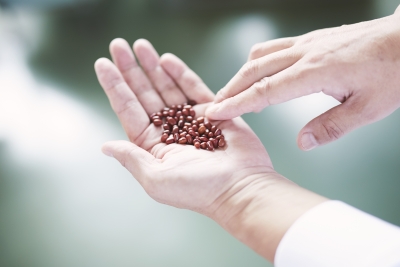Toraya—Aiming for the Future as an Establishment Steeped in History and Tradition

Since its founding in the late Muromachi period about 500 years ago, confection manufacturer Toraya has continued to carry forward the history and culture of wagashi—or traditional Japanese confections—and today is an established name both in Japan and abroad. Toraya became a purveyor to the Imperial Court during the reign of Emperor Go-Yozei (1586–1611), and for centuries has catered to the needs of its patrons. The company has also continued to develop new wagashi for overseas markets and to further extend the reach of its delicious flavors and unique charms. With the aim of taking over Toraya, Mitsuharu Kurokawa, the 18th and current head of the company, crossed over to study in the US while still at high school, and followed this up by accumulating vast experience in a range of settings, including wagashi production sites, the company’s boutique in Paris, and external roles in foreign trade. Here we speak to Kurokawa, who assumed the role of president in 2020, about the company’s management philosophy— to share the pleasures of traditional Japanese sweets(wagashi )—maintaining traditions as a long-established store, his forward-looking strategies for the future, and various other initiatives.
Wagashi’s Role in the Traditions of Japanese Food Culture
Wagashi has always held an important role in the world of traditional Japanese cuisine—while providing an array of delightful flavors, wagashi has been a bearer of culture, communicating the seasonal beauties of nature through stunning designs and unique naming. More recently, wagashi has been garnering worldwide attention as a healthy snack made using predominantly plant-based ingredients.
Kurokawa tells us, “Although wagashi can contain a small amount of egg, it is mainly made of beans, sugar, agar, and other plant-based ingredients. At Toraya, we only use carefully selected natural ingredients. Weather and other factors can impact the quality of these ingredients, and in turn the outcome of the product, and so in this sense wagashi is closely connected to nature. Wagashi makes use of seasonal elements throughout the year. One characteristic of wagashi, however, is that it expresses the seasons slightly ahead of time. When a product designed with a cherry blossom motif are on sale, for example, you may sense the arrival of spring, while products made with young chestnuts, sense the advent of autumn. And so, instead of simply offering delicious flavors, wagashi’s individuality and charm lies in its ability to portray the changing seasons.” As Kurokawa says, wagashi could be said to be a fundamental aspect of Japanese culture that is representative of the appeals of Japanese cuisine.
Kurokawa continues, “Recently, wagashi has been consumed in various settings partly due to its plant-based origins. For example, some of our most popular products are yokan, or gelled sweet bean paste. Yokan are free of any additives and ideally suited to supplementing energy as they are high in sugar and low in fat. They are therefore being increasingly used by athletes as a plant-based energy-boosting food product. Elsewhere, yokan have also been attracting attention as a part of emergency food stockpiles as they can be kept for up to a year at room temperature. To ensure that our products can be consumed safely and with peace of mind, we conduct thorough product management to ensure the highest quality in every facet of our business, from the ingredients we use to the production and delivery of our products.”
Toraya continues to dedicate itself to the production of delicious confections, but according to Kurokawa, it is important to make adjustments to be certain that wagashi is well-received by customers overseas and by customers in Japan who are not familiar with the concept. Kurokawa says, “I believe it is essential that customers see wagashi as attractive, stylish products.” With quality items, it’s important to constantly examine how to show and present the product in order to attract widespread attention and gain the understanding of the consumer. Here, Kurokawa says that there are many things that can be learnt from overseas, such as high-quality displays and effective communications.
Trying New Things to Maintain Tradition
For a roughly 500-year-old company, communicating long-held traditions and customs is an important yet challenging part of business. “The biggest change in Toraya’s history was during the Meiji period, when we moved operations from our founding location in Kyoto to Tokyo in line with the transfer of the capital. This move was the decision of the 12th generation head of the company, and I’m certain it was a much more difficult undertaking than expanding overseas is today. We had spent more than 300 years in Kyoto, and I’ve no doubt that starting work in an entirely new place came with lots of worries,” says Kurokawa. Of course, it is not as if Kurokawa has any direct recollection of this time, but it is clear that he can understand the struggles and decisions made by the 12th generation proprietor. For a business that had for so long been a purveyor to the Imperial Court, staying close to its valued customers and carrying on as a purveyor was almost certainly a priority.
Later, in 1980, Toraya opened a boutique in Paris, where it initially struggled with the differences in food culture. As Japanese cuisine was not as well-known in France as it is now, among other issues, the company’s yokan were mistaken as bars of black soap. Several years after the boutique’s opening, however, the company engaged in various new initiatives to establish wagashi and Japanese food culture in France. Among others, it incorporated familiar fruit into its yokan for French consumers, and used animal-based ingredients in its cafe menu. To celebrate the Paris boutique’s 40th founding anniversary, Toraya collaborated with the famous French patisserie Pierre Herme Paris, incorporating one of Pierre Herme’s most popular flavor, Ispahan, into its wagashi. Taking on bold challenges like this is an incredibly significant aspect for Torayaartisans. The creation of new wagashi encourages these artisans to try out new ingredients, as well as new methods and techniques. It is the accumulation of challenges like these that help to enhance their expertise and techniques.
Kurokawa gives us an interesting example, “I remember eating a California roll overseas once and thinking to myself, ‘this isn’t sushi.’ But it’s thanks to creations like this that people developed an interest in sushi and had an opportunity to come into contact with it. Eventually, some of these people will come to Japan in search of the real thing. As a result, recognition of sushi increases, and in turn the quality of sushi overseas improves. Right now my aim is to enable people from across the world to enjoy wagashi in their own way.” It is plain to see how Kurokawa wants wagashi to become an important communication tool to help people around the world interact across borders.
Linking the Past 500 Years to the Next
Despite the wagashi industry being one that honors its traditions, it cannot be said that simply sticking to old ways is the best way forward. “For me, the important thing is to strike a balance between maintaining tradition and challenging new things. If we look at ingredients, and at azuki beans in particular, to date we have used high-quality domestic produce. It is because there has been such demand for azuki beans that their quality has improved. And, thanks to the very nature of Japanese people, the care and detail that goes into their sorting post-harvest has helped to improve this quality even further. On the other hand, major azuki bean producing regions have started to change due to a range of factors, including climate change. At the same time, with major developments in means of transportation, it is highly probable that in the future, azuki beans produced overseas will boast a level of quality that is on par with, or perhaps even exceeds, that of those produced in Japan,” says Kurokawa, demonstrating his flexible approach.
It is said to take some decades to develop new varieties of azuki beans. This timescale, though, shows Kurokawa’s dedication to continuing to create delicious products for decades to come. Of course, consumers’ preferences for sweetness and flavor, for example, will change with time. As such, it is essential that Toraya remains sensitive to these changes and carefully examines what exactly it is that consumers want. “Although there were some changes during the pandemic, nothing can change too drastically in two or three years,” says Kurokawa. This idea that the fundamentals of food are unwavering has more weight coming from a long-established store like Toraya.
With regards to management, Kurokawa says, “One approach is to gain profit in the short term and sell out in five years. This is of course one method, but at Toraya we do it differently. Our approach is to continue producing wagashi, partly to carry on techniques that should be maintained, and examine whether we can keep doing the same thing for 30, 40, or 50 years. Using our experiences from the past 500 years, we believe it is important to carry on doing the same thing for the next 500 years.” In this way, Kurokawa has made slight changes in line with consumer needs and changing times while maintaining and unshakeable axis.

.jpg)






